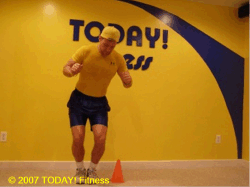That's because "any movement helps," according to Gregory Florez, a spokesman for the American Council on Exercise and chief executive of the FitAdvisor health coaching site.
Exercising at moderate intensity, even in short bursts of 10 minutes several times a day, or doing daily activities such as running errands can improve your health and probably lengthen your life, recent research suggests.
"Small bouts of activity, even 10 minutes at a time, will have the same impact as 30 minutes or so of continuous exercise," Florez said, if those small bouts are repeated three times a day.
Two recent studies indicate that you don't have to be a marathoner in training to reap the health benefits of exercise or even to get a little fitter.
In one study, published recently in the Journal of the American Medical Association, relatively modest amounts of activity by older people, ages 70 to 82, paid off in longevity.
The research team, led by Todd Manini of the National Institute on Aging, followed 302 older adults for six years. The researchers found that death rates went down as daily energy output - sometimes doing things as simple as vacuuming or running errands - went up.
Those people in the highest third of daily energy output had a 69 percent lower risk of dying during the follow-up than those in the lowest third, the researchers found. Those in the highest third also burned about 600 more calories a day than those in the lowest third. Even short bursts of physical activity made a difference in the calorie-burning group: The people were more likely to walk up two flights of stairs a day, for instance.
The extra reduction in 600 calories per day translates, the study authors said, to about two hours of activity. But it could be any activity: traditional exercise, washing dishes, vacuuming, running errands.
In a study published in the May 16 issue of the Journal of the American Medical Association, researchers said as little as 72 minutes of moderate exercise a week could improve aerobic fitness. The investigators looked at 464 sedentary, overweight women, average age 57.
One group worked out on a stationary bike or treadmill at moderate intensity for an average of 72 minutes a week. Another group did the workout for 136 minutes a week, on average. A third group worked out for 192 minutes a week. A fourth group did no exercise and served as the control group.
A fitness test at the end of the six-month study found that women who exercised for 72 minutes improved fitness by 4 percent. The 136-minute group improved fitness by 6 percent while the 192-minute group improved by 8 percent.
ref. HealthDay Jul. 9, 2007



